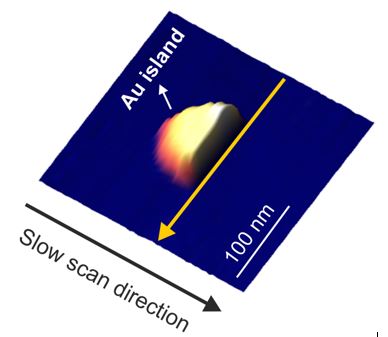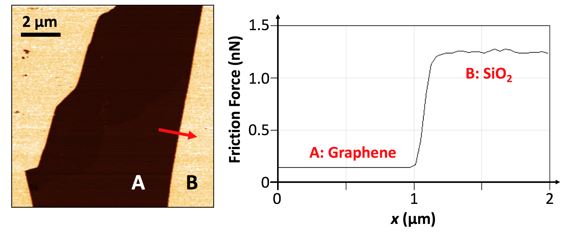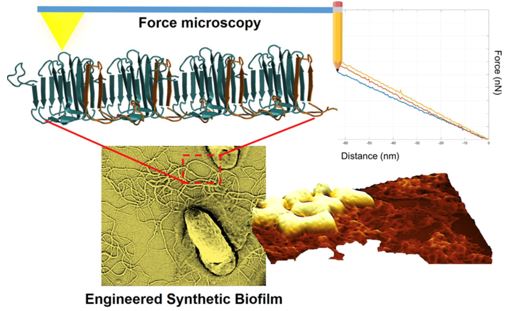The Baykara Lab, located at UC Merced, has been established in 2018 with the aim of exploring mechanics and tribology at the nanoscale.
-
Superlubricity under Ambient Conditions
-
Nanoscale Tribology of 2D Materials
-
Imaging and Mechanical Spectroscopy of Biological Materials
Superlubricity Under Ambient Conditions
The idea of structural superlubricity holds immense potential for the realization of nearly frictionless sliding in mechanical systems, with implications for fields as diverse as environmental conservation and space travel. The basic principle of structural superlubricity involves the proposition that friction should diminish at an interface formed by atomically-flat and molecularly-clean crystalline surfaces with different lattice parameters and/or incommensurate orientation. Despite the rather straightforward character of its basic principle, the realization of structural superlubricity under ambient conditions has been challenging due to the requirement of molecular cleanliness at the interface.
We have recently shown via AFM-based nano-manipulation experiments that gold and platinum nano-islands slide in a structurally superlubric fashion on graphite under ambient conditions, overcoming the widely-accepted theoretical prediction that molecular contamination would inevitably lead to the breakdown of structural superlubricity under ambient conditions [1, 2]. Our ongoing work involves the development of a complete understanding of remaining physical challenges for structural superlubricity, and devising novel methods to overcome them.

Figure 1. Three-dimensional representation of an AFM image detailing the lateral manipulation of a single gold island on graphite. The island is manipulated by the AFM tip along the yellow arrow.
[1] E. Cihan, S. Ipek, E. Durgun, M.Z. Baykara, Nature Communications 7, 12055 (2016)
[2] A. Özoğul, S. Ipek, E. Durgun, M.Z. Baykara, Applied Physics Letters 111, 211602 (2017)
Nanoscale Tribology of 2D Materials
To extend the lifespan of mechanical systems, wear and friction must be minimized via the utilization of lubricants. On the other hand, traditional fluid-based lubrication schemes fail in nano- and micro-scale systems due to increasing surface-to-volume ratios and associated physical effects. As such, research efforts in recent years have been aimed at characterizing the structure and mechanical properties of various candidates for solid lubricants at increasingly small length scales. In this ongoing project, we utilize AFM to elucidate the fundamental physical mechanisms governing the tribological properties of 2D materials, including but not limited to the "wonder material" graphene [3, 4].

Figure 2. Friction force map acquired on an exfoliated graphene flake (A) situated on a SiO2 substrate (B) via AFM, as well as the corresponding friction force profile along the red arrow.
[3] Z. Ye, A. Balkanci, A. Martini, M.Z. Baykara, Physical Review B 96, 115401 (2017)
[4] T. Demirbaş, M.Z. Baykara, Journal of Materials Research 31, 1914 (2016)
Imaging and Mechanical Spectroscopy of Biological Materials
AFM is a versatile and powerful tool with the capability of nanometer-scale-resolution investigation of a large class of material surfaces. AFM is particularly advantageous in imaging and mechanical spectroscopy of biological materials due to the wide range of environments in which it may be operated.
Using high-resolution AFM measurements under ambient conditions, we have previously shown that the morphology and the mechanical stiffness of functional amyloid nanofibers produced by e. coli bacteria can be genetically tuned [5]. Our current efforts involve extending our AFM imaging and spectroscopy capabilities to liquid environments, as well as different micro-organisms of fundamental and practical relevance.

Figure 3. Schematic illustration of AFM-based imaging and spectroscopy experiments on engineered synthetic biofilms.
[5] M.T. Abdelwahab, E. Kalyoncu, T. Onur, M.Z. Baykara, U.O.S. Seker, Langmuir 33, 4337 (2017)
The research activities presented here are being led by the Baykara Lab (PI: Dr. Mehmet Baykara).



